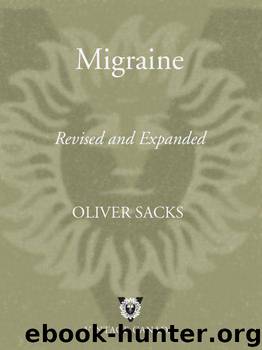Migraine by Sacks Oliver

Author:Sacks, Oliver [Sacks, Oliver]
Language: eng
Format: epub, mobi
ISBN: 9780307371065
Publisher: Knopf Canada
Published: 2012-05-08T04:00:00+00:00
33 A similar miscellany of arousing circumstances may provoke many analogous reactions as, for example, hayfever. As Sydney Smith remarked of himself in this connection: “The membrane is so irritable, that light, dust, contradiction, an absurd remark, the sight of a dissenter, anything, sets me asneezing.”
34 We must make an observation, in this context, which may be applied willy-nilly to many of the odder and more idiosyncratic circumstances sometimes held responsible for migraine attacks, viz. that a true organic sensitivity may be mimicked by what Living would call a “pathological habit,” namely a conditioned reflex. We may remember such patients with “rose-fever” who start to sneeze if presented with a paper rose.
35 It is not uncommon for patients to dream of an aura, or to experience, either frank or camouflaged, the entry of aura phenomena into the flow of dreams, and it is always important to enquire whether patients have such dream-auras. I describe a personal experience of such a dream-aura in A Leg to Stand On (pp. 95–101), and have discussed the general subject in “Neurological Dreams,” MD Magazine, February 1991.
36 A charming example of an aural response to visually-patterned and intermittent stimulation is provided by a case-history cited in Liveing, in which the patient’s attacks were evoked by the sight of falling snow, and no other circumstance.
37 Since drafting the original manuscript, I was fortunate enough to be given the detailed case-history quoted in Chapter 3 (Case 75), in which migrainous paraesthesiae, in company with other symptoms of an aura, were apparently evoked by resonance to an oscillatory tactile stimulus of appropriate frequency.
38 There is, of course, a strong moral undertone to such regimens, as is true of so many successful ways of treating migraine. Sydney Smith, who suffered from haytever, stresses the ascetic nature of his treatment: “… I am taking all proper care of myself, which care consists in eating nothing that I like, and doing nothing that I wish.”
39 There are innumerable examples of such self-perpetuating symptoms, in which there is a reverberation of stimulus and response, or a maintained opposition between them—a sort of physiological echoing. A familiar example is Parkinsonian tremor (reverberation) and Parkinsonian rigidity (maintained opposition). In all such cases one must think—as in the perpetuation of a migraine—of inertia and momentum.
40 A familiar example of such a peripheral autonomic interaction is the gastrocolic reflex—emptying of the bowel in response to filling of the stomach. This universal post-breakfast reflex is apparently not mediated by central mechanisms at all, but by a direct signalling from stomach to colon, a “sympathy” between these two parts of the gut.
41 The history of hysteria provides many familiar examples of such a merging between expectations and symptoms. Thus Charcot’s depiction of hysteria was responsible for the frequent occurrence of the symptoms he depicted. With his death, and the changing of medical expectations, the forms of hysteria changed in turn.
Download
This site does not store any files on its server. We only index and link to content provided by other sites. Please contact the content providers to delete copyright contents if any and email us, we'll remove relevant links or contents immediately.
Rewire Your Anxious Brain by Catherine M. Pittman(18490)
Talking to Strangers by Malcolm Gladwell(13132)
The Art of Thinking Clearly by Rolf Dobelli(10141)
Mindhunter: Inside the FBI's Elite Serial Crime Unit by John E. Douglas & Mark Olshaker(9103)
Becoming Supernatural by Dr. Joe Dispenza(8039)
Change Your Questions, Change Your Life by Marilee Adams(7564)
The Road Less Traveled by M. Scott Peck(7473)
Nudge - Improving Decisions about Health, Wealth, and Happiness by Thaler Sunstein(7459)
The Lost Art of Listening by Michael P. Nichols(7359)
Mastermind: How to Think Like Sherlock Holmes by Maria Konnikova(7163)
Enlightenment Now: The Case for Reason, Science, Humanism, and Progress by Steven Pinker(7084)
Win Bigly by Scott Adams(7032)
The Way of Zen by Alan W. Watts(6451)
Daring Greatly by Brene Brown(6368)
Big Magic: Creative Living Beyond Fear by Elizabeth Gilbert(5555)
Grit by Angela Duckworth(5447)
Ego Is the Enemy by Ryan Holiday(5226)
Men In Love by Nancy Friday(5113)
Altered Sensations by David Pantalony(5003)
